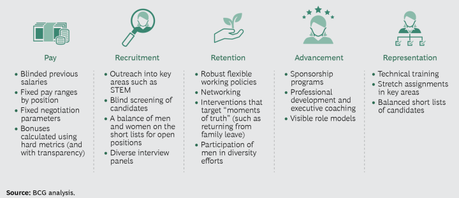Header image: Lara Speirs, Executive VP & General Counsel, Randstad Canada
On May 8, I co-hosted the first #RandstadTechTalks Twitter chat with Randstad Canada, and heard from dozens of Canadians on topics surrounding the Canadian role in the globalizing future.This 2-part blog post was inspired by the topics discussed in that Twitter chat, a conversation with Randstad’s Executive VP & General Counsel, Lara Speirs, and my own experience as CTO of Crescendo and research in the Future of Work.
Part 1: The future of work is flexible and diverse.
Nowadays, especially for people in tech roles, remote work and flexibility is expected. With the rapid growth of tech jobs over the past few years and not enough professionals to fill them, employees have used their leverage to influence the physical transformation of our working arrangements. I don’t even know what it’s like to work on a colocated team – I personally have never worked in the same city as any of my managers – and for the incoming generations of workers, this is the norm.
70% of people worldwide work remotely at least once per week, and trends show that the full time remote workers will equal or surpass traditional office workers in 2025 (IWG). At my startup, Crescendo, we are a semi-distributed and remote-friendly team. Like many innovative workplaces across Canada, we recognize that everyone comes to work with a different life situation. Speaking to Lara Speirs, Executive VP and General Counsel, Legal & Public Affairs, of Randstad Canada, I learned of another trend: many workplaces are switching to a results-only workplace environment, or “ROWE,” model. This means focusing on the outcome of the work – where and when you do it doesn’t matter. “The ROWE strategy is increasing in popularity, and with good reason. Women are disproportionately affected by a lack of flexible work arrangements, so this approach appears like a very interesting way to truly integrate work-life balance in the workplace” she says. ‘’There’s no doubt that flexibility makes for a more inclusive workplace. But there’s a caveat: the ROWE model can only be implemented in a high-trust environment.’’
With this more flexible workplace, companies are beginning to hire beyond their own borders. Tools like Slack, Zoom, Miro, and Drive make it easy to collaborate with your colleagues in real time, regardless of physical location. So why not hire someone in a different city, country, or continent? In fact, doing so may even help your organization and your team.
The great thing about tech products is they can reach users all around the world with just a couple of clicks. But people often overlook how much you need to localize the product to each market you enter. It’s not enough to just change the language, scale your servers, and turn your app or software on for users in other locales. You have to consider the different needs and cultures of users in each market and cater to them specifically. In my recent trip to Japan for the G20 YEA Summit, for which I also partnered with Randstad Canada, I heard Ray Hatoyama share how thinking local helped him turn Hello Kitty into a household name not just in Japan, but around the world. Hiring people who represent the markets you are trying to reach helps you reach those markets more effectively.
. . .
Historically, diversity was often sidelined as a nice-to-have, not a necessity. It was traditionally run by HR, but in recent years has broken out of that vertical and into the core of organizations. Nowadays, companies are being pressured by legislation, consumers, and employees to diversify their workforces, and they’re finally allotting big budgets to these initiatives. In recent years, the number of roles relating to diversity and inclusion in North America has skyrocketed. “D&I shouldn’t just be run by the head of HR,” says Speirs, who was also formerly Randstad Canada’s Chief Diversity Officer. “It should be [a priority] starting from the CEO and at all levels of the C-Suite and cascading down from there.”
But it’s not enough to just set goals for diversity, the organizations that are doing this successfully focus on inclusion and belonging – it’s not just about hiring a set of diverse people, it’s also about the employee experience once they’re there. “Having key measures in place is important,” Speirs says. She cites a BCG study (excerpt below), which proposes core measures for successful gender equity programs, as a good example of strong measures of a successful initiative.

Using frameworks like these add clarity and fairness to otherwise imbalanced processes where bias can easily slip through.
To illustrate the state of women in the workplace, Randstad recently released their Women Transforming the Workplace report, which is part of their larger initiative of the same name. Beyond the typical gender diversity study, it takes a look at what Canadian women think of the “fourth industrial revolution,” the blurring of boundaries between AI and humans. “There’s a critical need for women to actively participate,” the report says, “or we risk being left behind.”
Tune in to my Instagram Live with Carolyn Levy, President of Randstad Technologies, on Tuesday, July 23rd.
. . . . .
Part 2: The future of work is AI-powered and empathy-driven.
It becomes more tempting every day to offload our work to machines (and when I say ‘machines’ here, I really mean code). Machine learning is becoming ever more powerful, and we are on track towards a future in which machines will do most of the tasks we currently consider to be employable.
It will begin with the repetitive tasks – in fact, it already has. Jobs that perform a few specific functions and require a high volume of repetition are being replaced by machines who can do the same work, faster, and more consistently. This is happening today, and we’ve seen many companies replace their front-line and warehouse workers with digital counterparts. Next affected will be the jobs that have more variance in responsibility and require data. In terms of job replacement, when you boil it down, machine learning is essentially just automated human decision-making; the algorithms use large volumes of historical data to learn how humans respond to different situations, and make the most similar decision (not necessarily the best decision, but we’ll tackle that later). It follows, then, that as we collect more data about ourselves, our companies, and our world, we will hand off more components of our roles to machines. After all, isn’t it always better to have something done quicker AND more accurately?
Maybe not. When we give machines too much autonomy over humans, we remove the compassion from the equation. Some workplaces are turning to machines for personnel decisions, allowing them to automatically terminate underperforming employees without taking into consideration the whole context of why the person might be performing slower than usual. It’s so important that we keep humans in the loop in decisions like these – machines are great at processing large volumes of data in short periods of time, and we should continue to use them for that, but the final decision should always be brought by a human. And when machines make biased decisions, underrepresented people are disproportionately affected. If we don’t correct the human bias in the data, or provide opportunities for people to notice when a biased decision has been made, the machine will just further the human biases of the past.
So what does this mean for us?
At this point, machine integration is an inevitability. In a survey of 1201 Canadian women, Randstad found that 30% of working Canadian women are worried about losing their jobs to technology over the next 5-10 years, yet 54% of women are not currently doing anything to protect their careers from being negatively impacted by technology. 65% think employers should help them find another job in the organization when their job is replaced by automation (Randstad Canada, 2019). We can’t stop the growing ubiquity of machine learning, we can only work on ourselves and reshape our approach to work. We’ll need people in strategic places, and we’ll need to have people whose jobs are specifically to ensure that decisions are made with the right context taken into account. Another way we can do this is by refining our soft skills. Machines are great at those repeatable, consistent tasks, but they’re not as great at the things that make us human. According to Randstad, 44% of Canadian women identify empathy as the top skill they bring to the workplace. Here’s what some of you had to say during #RandstadTechTalks:
Machines can make decisions based on data, but only humans can make decisions that give other humans the benefit of the doubt – decisions based on intuition and compassion, regardless of past behavior. We need to continue to hone and use our intuition.
— R.C. Woodmass ᴛʜᴇʏ/ᴛʜᴇᴍ (@rwoodmass) May 8, 2019
Compassion, empathy, and creativity are big ones for me – but storytelling tops the list. Don't underestimate the power of building a narrative to get buy-in from customers, stakeholders, and employees! #RandstadTechTalks
— Amy Morris (@amymorrisdesign) May 8, 2019
If we’d had this conversation five years ago, everyone would have been talking about the importance of learning to code. I’m a developer myself, and a proponent of computer science education, but it has become clear that not even developers are ‘safe’ from role automation. It’s the more metaphysical skills that professionals of the future will use to pull ahead of their machine counterparts – like Amy and RC shared in the Tweets above, compassion, empathy, intuition, and creativity are skills in the human wheelhouse that are harder for machines to develop. We’re already seeing workplaces prioritize these in the hiring process, and it will only become more important as machine learning becomes more sophisticated.
. . .
Where do we stand today?
We are in a period of immense change. Technology is advancing faster than ever before, equally stirring up excitement and concern about the AI-powered future. Companies are recognizing the importance of diversity and inclusion, and are working towards fostering healthier, more flexible workplaces. We as innovators are in a position to influence the evolution of the workforce.
Key takeaways:
- Companies are going global, and tech companies expand internationally faster than any other industry. More than half of roles will be fully remote by 2025.
- Diversity is not just important, but imperative. The companies who embrace diversity and foster inclusive workplaces will be the ones who pull ahead in the globalization race.
- ML is advanced, but it’s not a silver bullet – stop and think before you use an ‘AI’ solution. Beware the products that offer to solve all your problems with machine learning, and consider the following: How does it introduce room for bias? Where will the final decision be made? By whom?
The future of work has already begun.
. . . . . . .
This article was written as part of my larger partnership with Randstad Canada. I choose my partners very carefully, and what I love about Randstad is the team’s commitment to listening to the community and highlighting people, especially underrepresented people, who are doing great work to make the future more #humanforward.
. . . . . . .

